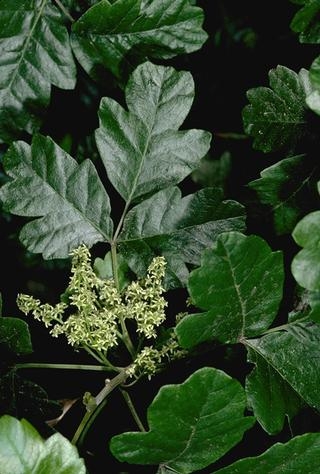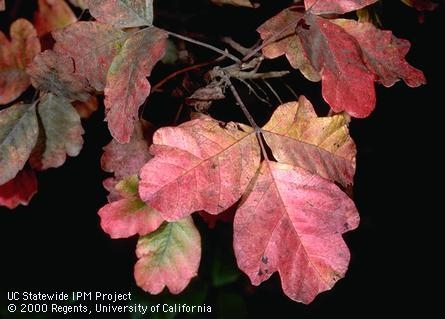[From the August 2013 issue of the UC IPM Green Bulletin newsletter]
Removal of poison-oak requires special care. Most people are allergic 
Poison-oak can be removed through mechanical methods, but most managers combine mechanical and chemical control. Grazing by sheep and goats can be effective in small areas. Don't burn poison-oak, since it creates a serious health hazard and doesn't effectively reduce infestations.
Mechanical control
You can physically remove plants located in a yard or near houses through hand pulling or mechanical grubbing using a shovel or pick. It is essential to remove the entire plant including its roots. Remove plants in early spring or late fall when the soil is moist and it is easier to dislodge rootstocks. Grubbing when the soil is dry and hard usually will break off the stems, leaving the rootstocks to vigorously resprout. Detached and dried brush still can cause dermatitis, so bury or stack the plant material at an out-of-the-way location, or take it to a disposal site. Again, never burn poison-oak.
Ideally, anyone engaged in hand pulling poison-oak should have a high degree of tolerance to the allergen. Whether you are sensitive or believe you are immune, wear appropriate protective clothing, including washable cotton gloves over plastic gloves. Wash all clothing thoroughly, including shoes, after exposure. In case of contact with poison-oak, shower immediately after handling plants to reduce risk of absorption of plant oils into skin.
Other forms of mechanical control have not proven to be successful. Brushrakes and bulldozers often leave pieces of rootstocks that can readily resprout. In some cases, brush removal late in summer, when plants are experiencing moisture stress, can slow their ability to recover. Mowing has little effect in poison-oak control, unless you perform it at least four times during the growing season. Within 2 months of germination, young plants usually have produced underground rootstocks large enough to recover from mowing damage. A single plowing is of no value and often serves to propagate and spread the shrub. However, good seedbed preparation and planting cultivated crops for a year or more will help control poison-oak infestations.
Herbicides
A variety of herbicides are available for poison-oak control. Effectiveness depends on timing of application. Always follow label instructions when applying herbicides.
Stump Application. Stump treatments are most effective during periods of active growth. Cut poison-oak stems 1 to 2 inches above the soil surface, and apply the herbicide immediately to the stump surface. A delay in treatment will result in poor control. Apply an herbicide such as glyphosate or triclopyr with a paint brush that is 1 to 2 inches wide or with a plastic squeeze bottle that has a spout cap. Treatment solutions should contain either undiluted glyphosate (use a product that contains at least 20% glyphosate), triclopyr amine, or a 20 to 30% triclopyr ester solution mixed with 70 to 80% methylated or ethylated seed oil.
Be sure to completely cover all surfaces of the stumps with the herbicide until it runs down the base of the stubs. Spray any regrowth from cut stumps with a foliar spray when the leaves fully expand. Always wear gloves and avoid direct contact with plant to avoid risk of dermatitis.
Basal Application. Basal bark applications can be made almost any time of the year, even after leaves have discolored or dropped. Apply 20% the ester form of triclopyr to basal regions of poison-oak using a backpack sprayer with a solid cone, flat fan, or a straight-stream spray nozzle. Mix with 80% oil carrier (such as seed oil) to enhance herbicide uptake across the bark. Thoroughly cover a 6- to 12-inch basal section of the stem, but not to the point of runoff. Water soluble herbicides, such as the amine form of triclopyr and glyphosate, will not be able to penetrate into the bark and, thus, give no control.

To achieve spray-to-wet coverage, all leaves and stems should be glistening following herbicide application. However, coverage should not be to the point of runoff. One application of an herbicide does not usually control poison-oak completely. Treat again when new, sprouting leaves are fully expanded, generally when the plants are about 2 feet tall. Watch treated areas closely for at least a year, and re-treat as necessary. Herbicides used for foliar treatment of poison-oak include imazapyr, glyphosate (must be at least 2%), triclopyr amine or triclopyr ester plus 2,4-D ester, and dicamba.
[Adapted from J. M. DiTomaso and W.T. Lanini. Pest Notes: Poison Oak. UCANR Publication 7431. For more information, view this publication online at http://www.ipm.ucdavis.edu/PMG/PESTNOTES/pn7431.html]
This article was originally published in the August 2013 issue of the UC IPM Green Bulletin. See this and other articles at http://www.ipm.ucdavis.edu/greenbulletin/index.html.